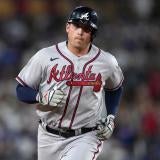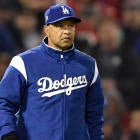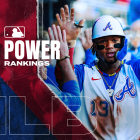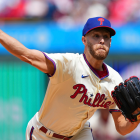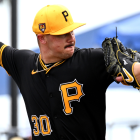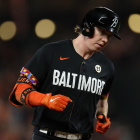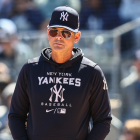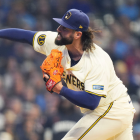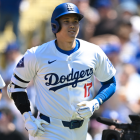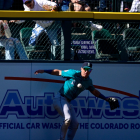By many measures, the Dodgers were an outstanding team last season.
They won their sixth straight NL West title. They made it to the World Series for the second year in a row. Their hitters led the majors in park-adjusted offense, while their starting rotation ranked in the top three by both park-adjusted ERA and fielding-independent metrics. They scored 194 more runs than their opponents, by far the best run differential in the majors -- a number so impressive, their expected record would have produced 103 wins.
And yet, the 2018 season felt disappointing, for multiple reasons. The Dodgers won 11 fewer games than you'd expect when glancing at their run differential, eking out that NL West crown only by beating the Rockies in a one-game playoff. They were haunted by some of the same bugaboos that have plagued the team for much of this six-year run, with a 22-22 record in one-run games highlighting their struggles in high-leverage situations.
So what went wrong? The answer lies in a combination of bad luck and flawed roster building that got exposed at the worst possible times.
Relief pitching has been the team's Achilles' heel for much of this close-but-no-cigar era. While Kenley Jansen has held down the fort as one of the best closers in the league, his bullpen running mates have frequently ranged from mediocre to downright flammable. That wasn't the case in 2018. While the Dodgers' pen wasn't elite last season, it did finish 13th in the majors in park-adjusted ERA. When you've got the best offense in baseball, a top-three rotation, a deep bench, and a pen that's a tick better than league average, you'd typically expect great things to happen.
- 2018 Result: 92-71, first place in NL West
- Key free agents: Manny Machado, Yasmani Grandal, Brian Dozier, Ryan Madson, John Axford, Daniel Hudson
- Needs: Catcher, relief pitching
But while the pen did still experience its share of setbacks, perhaps the biggest reason the Dodgers didn't break their 30-year World Series drought was their woeful performance at the plate when the stakes were highest. During the regular season, the Dodgers hit an atrocious .199/.327/.312 with two outs and runners in scoring position. Compare that mark to the team's overall line of .250/.333/.442, and you might think the Dodgers bought up every piece of property in Chokesville.
Of course we know that baseball is a lot more complex than that, and that invoking a team's shaky knees in big spots is a facile and misleading explanation for such stinky results. Instead, we might turn to a stat liked Cluster Luck. Coined by analyst Ed Feng, Cluster Luck looks at how often teams would be expected to score runs assuming they were neither lucky nor unlucky at bunching hits together. If the team was scoring fewer runs than expected, that would mean they'd failed to string hits together; a better-than-expected result would mean they'd found some good fortune in mounting extended rallies. By this metric, the Dodgers offense left more runs on the table than all but three other teams in 2018.
Even that stat is more of a summary than an explanation, though. Was there some characteristic of the 2018 Dodgers that made them less likely to come through in big spots?
The answer is a resounding probably. Red Sox manager Alex Cora earned universal plaudits for his ability to outmaneuver Dodgers skipper Dave Roberts in the World Series. But while Cora earned his stripes as one of the game's brightest managers, he also exploited a weakness that had more to do with the ingredients handed to Roberts than the lineup stew he cooked up. Namely, that the Dodgers were arguably the most platoon-reliant team in all of baseball.
Lefty sluggers Cody Bellinger and Joc Pederson (two of the team's top three home-run hitters in 2018) both mashed right-handed pitching but struggled mightily against left-handers. Yasiel Puig bats right-handed, but showed a similar split last season, albeit a reverse split in his case. The Dodgers mitigated those heavy splits at the start of games by deploying multiple lefty-crushers, including Enrique Hernandez and David Freese.
The problems occurred in the middle and later innings of games. In the regular season, managers could sometimes exploit the Dodgers' platoons, bringing in alternating lefty and righty relievers to make Roberts burn his bench and put one-dimensional hitters in tough spots. Those opposing managers could only do so judiciously, though, for fear of burning out their bullpens. In the playoffs, managers aren't restricted in the same way. More frequent days off allow skippers to use their best relievers as often as they please, with the added justification that for the team's purposes, there really is no tomorrow.
So that's just what Cora did. Using a combination of quick hooks and an all-hands-on-deck mentality from his pitching staff, the Red Sox neutralized the Dodgers potent offense during some of the biggest moments of the World Series.
This is why the Dodgers' hot stove shopping list looks different than most other teams' lists. Sure, L.A. must address some conventional needs, with the free agency of Yasmani Grandal and multiple relievers creating obvious holes behind the plate and in the bullpen. But more than that, don't be surprised if the Dodgers recast their roster using more complete players who are less likely to get snuffed out by same-handed pitching.
One such potential acquisition is White Sox All-Star first baseman Jose Abreu. Not only has the righty-swinging Abreu been one of the most prolific and consistent hitters in the league during his five major league seasons. He's also carried narrow batting splits. Against left-handed pitchers, he's slugged at a strong .300/.371/.539 clip. But he's been almost as potent against right-handed pitching, batting a solid .293/.347/.509.
Of course Abreu isn't the biggest name linked to the Dodgers in offseason trade rumors. L.A. has long been regarded as one of the most likely landing spots for superstar outfielder Bryce Harper. In Harper, the Dodgers would be acquiring a hitter who does in fact carry decent-sized splits (.288/.402/.543 vs. right-handers for his career, vs. .258/.354/.442 vs. lefties). But he's nowhere near the automatic out against southpaws that some of last season's weakest links were. And of course Harper is one of the most talented free agents in recent baseball history, a six-time All-Star and former MVP who's just 26 years old and could wreak havoc on opposing pitchers for many years to come.
The Dodgers might've relied as heavily on platoons last season as they did in part because they aggressively moved to duck under the league's luxury-tax threshold. In successfully doing so, they set themselves up to spend big this winter, right when available talent would be higher than it's been in years.
That tack got the Dodgers to the cusp of a World Series victory, but no further. With gobs of money to spend this winter and a clear mandate for how to improve, don't be surprised if Abreu is a Dodger soon, and if Harper and maybe another megatalent or two soon follow.
Jonah on the MLB offseason
NL East
Braves: May be offseason's most compelling team
Marlins: Finding where to send Realmuto
Mets: How Mets could jumpstart BVW era
Phillies: Harper or Machado might not be enough
Nationals: What will the Nats do if Harper leaves?
NL Central
Cubs: Keys to a Cubs rebound in 2019
Reds: Can Cincy revamp its pitching staff?
Brewers: Why Milwaukee should dig deeper in its war chest
Pirates: How Buccos can get aggressive
Cardinals: St. Louis can close the NL Central gap
NL West
Diamondbacks: How drastic will the rebuild be?
Rockies: Colorado needs bats to match pitching staff












